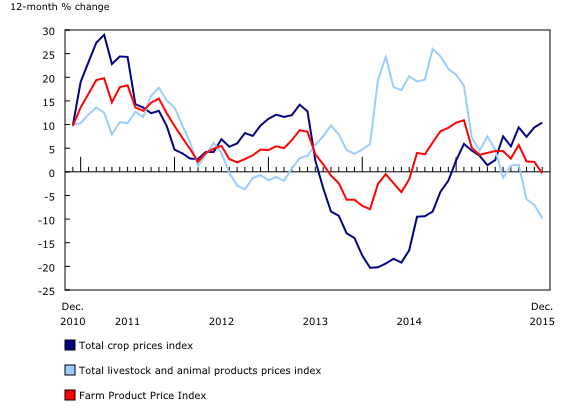Farm Product Price Index, December 2015
Archived Content
Information identified as archived is provided for reference, research or recordkeeping purposes. It is not subject to the Government of Canada Web Standards and has not been altered or updated since it was archived. Please "contact us" to request a format other than those available.
Released: 2016-02-25
The Farm Product Price Index (FPPI) declined 0.3% in December compared with December 2014, largely as a result of lower cattle and hog prices. This was the first year-over-year decrease in the index since August 2014.
The livestock and animal products index fell 9.8% in December compared with December 2014, the third consecutive month of year-over-year declines. Prior to these recent decreases, this index had been growing on a year-over-year basis since April 2013 (except for a slight decline in July 2015), boosted by rising cattle and hog prices.
The decrease in the livestock and animal products index was due to lower prices for hogs (-22.4%), cattle and calves (-7.9%), dairy (-5.7%) and poultry (-2.8%). Eggs (+0.7%) were the only commodity to record an increase.
Tight supplies had contributed to higher cattle prices, but pressure on supplies appears to be easing. The United States' cattle inventory as of January 1, 2016, was up 3% over the previous year, its second consecutive increase. The total number of head slaughtered in 2015 at government-inspected packing plants in Canada and the United States remained below 2014 levels. However, starting in November 2015 in the United States and in December 2015 in Canada, the number of head slaughtered at these plants increased year over year. These were the first year-over-year gains since December 2014 in the United States and since October 2014 in Canada.
The hogs index began posting year-over-year declines in February 2015 and has recorded double-digit decreases since. North American hog inventories started to increase in mid-2014. In 2015, hog slaughter rose 4.2% in Canada and was up 8.0% in the United States compared with 2014. According to the United States Department of Agriculture's latest quarterly hog inventory report, the hogs and pigs inventory as of December 1, 2015, was the highest since quarterly US estimates began to be produced in 1988.
The crops index rose 10.4% in December compared with December 2014, as most crops posted year-over-year gains. The grains (+5.8%), oilseeds (+4.9%), specialty crops (+39.2%), fruit (+1.8%) and potato (+11.4%) indexes all increased. Moderating the growth was a slight drop in the vegetable index (-0.2%).
Crop prices received by Canadian producers in December were mainly up from the same month in 2014, despite the International Grains Council's forecast of an ample world supply of grain this crop year. The depreciation of the Canadian dollar relative to the US dollar supported these prices.
The specialty crop index began to post year-over-year increases in November 2014, driven mainly by higher lentil and pea prices. Canada is the world's largest exporter of both peas and lentils, and higher demand, primarily from India, has supported the increase.
Compared with November 2015, the FPPI was down 1.5%, as a decrease in the livestock and animal products index (-5.6%) more than offset an increase in the crops index (+3.1%).
Note to readers
The growth rate of the total Farm Product Price Index (FPPI) is derived from a weighted average of the component indexes using a different set of weights in consecutive months; it is not a weighted average of the growth rates of its crop and livestock components. Given this, the growth rate of the composite FPPI can lie outside the growth rate of these components.
Contact information
For more information, or to enquire about the concepts, methods or data quality of this release, contact us (toll-free 1-800-263-1136; 514-283-8300; STATCAN.infostats-infostats.STATCAN@canada.ca) or Media Relations (613-951-4636; STATCAN.mediahotline-ligneinfomedias.STATCAN@canada.ca).
- Date modified:


